
SKIING HISTORY
Editor Kathleen James
Art Director Edna Baker
Contributing Editor Greg Ditrinco
ISHA Website Editor Seth Masia
Editorial Board
Seth Masia, Chairman
John Allen, Andy Bigford, John Caldwell, Jeremy Davis, Kirby Gilbert, Paul Hooge, Jeff Leich, Bob Soden, Ingrid Wicken
Founding Editors
Morten Lund, Glenn Parkinson
To preserve skiing history and to increase awareness of the sport’s heritage
ISHA Founder
Mason Beekley, 1927–2001
ISHA Board of Directors
John Fry (1930-2020), Chairman
Seth Masia, President
Wini Jones, Vice President
Jeff Blumenfeld, Vice President
John McMurtry, Vice President
Chan Morgan, Treasurer
Einar Sunde, Secretary
Richard Allen, Skip Beitzel, Michael Calderone, Christin Cooper, Art Currier, Dick Cutler, Chris Diamond, David Ingemie, Joe Jay Jalbert, Rick Moulton, Wilbur Rice, Charles Sanders, Bob Soden (Canada)
Presidential Circle
Christin Cooper, Billy Kidd, Jean-Claude Killy, Bode Miller, Doug Pfeiffer, Penny Pitou, Nancy Greene Raine
Business & Events Manager
Kathe Dillmann
P.O. Box 1064
Manchester Center VT 05255
(802) 362-1667
kathe@skiinghistory.org
Membership Services
Laurie Glover
(802) 375-1105
laurie@skiinghistory.org
Corporate Sponsorships
Peter Kirkpatrick
(541) 944-3095
peterk10950@gmail.com
Bimonthly journal and official publication of the International Skiing History Association (ISHA)
Partners: U.S. Ski and Snowboard Hall of Fame | Canadian Ski Museum and Hall of Fame
Alf Engen Ski Museum | North American Snowsports Journalists Association | Swiss Academic Ski Club
Skiing History (USPS No. 16-201, ISSN: 23293659) is published bimonthly by the International Skiing History Association, P.O. Box 1064, Manchester Center, VT 05255.
Periodicals postage paid at Manchester Center, VT and at additional mailing offices. Postmaster: Send address changes to ISHA, P.O. Box 1064, Manchester Center, VT 05255
ISHA is a 501(c)(3) public charity. EIN: 06-1347398
Written permission from the editor is required to reproduce, in any manner, the contents of Skiing History, either in full or in part.
Resorts: Pontresina
Just a few miles from glitzy St. Moritz, the cultural heart of this Swiss ski region beats quietly in Pontresina.
The history of the Swiss resort town of Pontresina is inextricably linked to its glamorous neighbor, St. Moritz, which lies five miles away. Pontresina has always played second fiddle to St. Moritz, which was the cradle of winter sports in Switzerland and hosted the Winter Olympics in 1928 and 1948.
Photo above: At 42 kilometers, the Engadin Skimarathon, the second
largest cross-country ski race in the world, is bucket-list worthy for 14,000 racers each March.
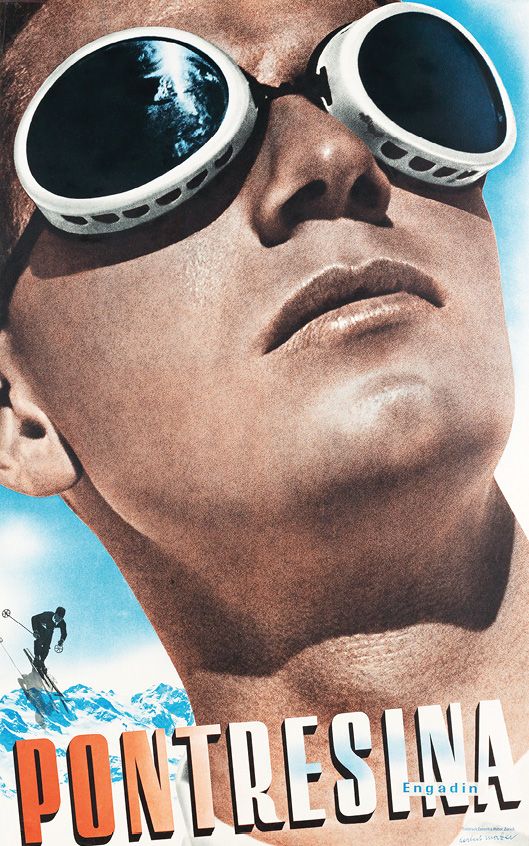
Today, St. Moritz is closer in spirit to Monaco, an outpost of the uber rich. But take a 10-minute drive along the Val Bernina, the high-altitude valley that branches off the Upper Engadin Valley, and you’ll discover the cultural heart of the region in Pontresina. Much smaller than its glamorous sibling, the town lies at 5,822 feet elevation and is laid out on a long ridge on the south-facing shelf of Alp Languard mountain. It is subtly elegant, and redolent of the Belle Epoque with its cobblestone streets and pastel-colored stucco houses.
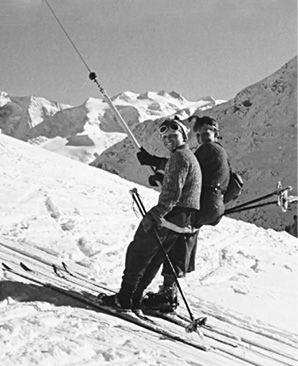
Many of these quaint buildings, which date back to the 17th century, are decked out in s’graffito, the stenciled plaster designs that are hallmarks of the region. The word itself is the origin of the term “graffiti” and the designs are of striking geometric patterns, fish, stars and whimsical beasts, along with sundials etched onto the sides of the homes.
The locals greet each other not with “Gruezi,” the Swiss German greeting, but “Allegra,” which is how one says hello in Romansch, the Latin-based mountain language. Less than 70,000 people still speak Switzerland’s fourth language (after German, French and Italian) and Pontresina is a bastion of Romansch. If you paid attention in 10th grade Latin class, you will be amazed at how much you can decipher.
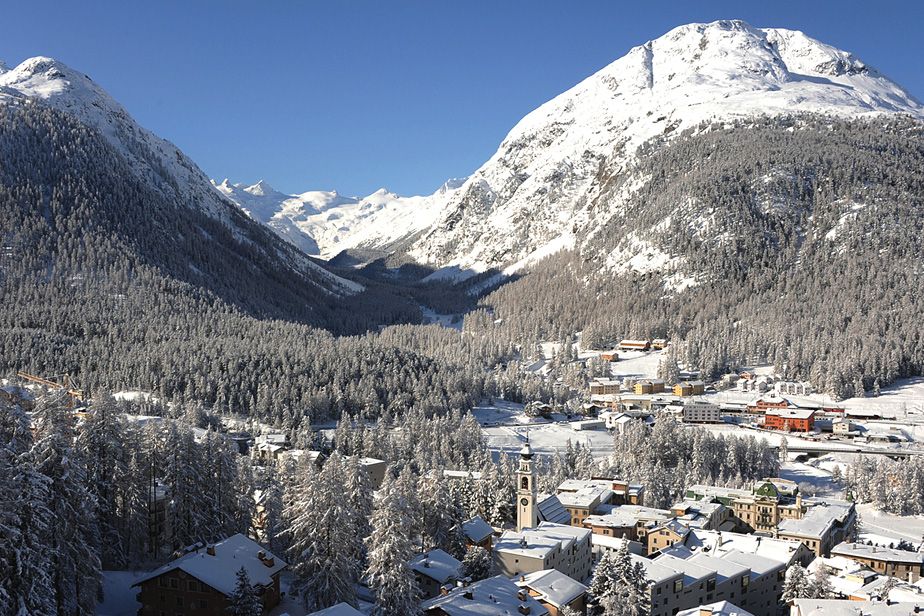
Pontresina offers astonishing panoramic views of nearby mountains, the Roseg Glacier and the pistes of Corviglia and Corvatsch that rise up behind St. Moritz. Surrounding this genteel, well-heeled town are pine and larch forests. It’s an alpine landscape that was beloved by Italian-Swiss artist Giovanni Segantini, who spent much of his life painting it.
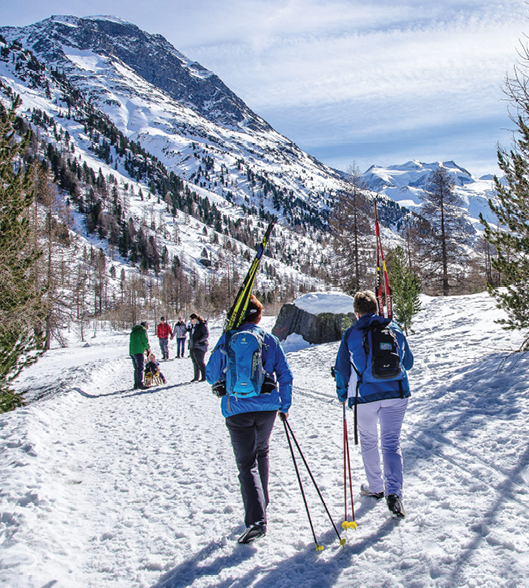
The main ski areas of Pontresina are Lagalb and Diavolezza, the latter resembling a giant, undulating meringue and offering glacier skiing as early as October and running as late as May. Closer to Pontresina is the Morterasch Glacier, the largest glacier by area in the Bernina Range of the Bündner Alps. There’s a 10km route along the glacier from Diavolezza, the longest glacier ski in Switzerland. So famed was the glacier that it was painted in the 19th century by Albert Bierstadt and drawn by John Singer Sargent. But what once was an attraction for Victorian visitors is now a poster child for vanishing glaciers. It has retreated nearly two miles since the late 19th century and in the past few years, the Swiss have enlisted snow guns to try and save the glacier from melting further.
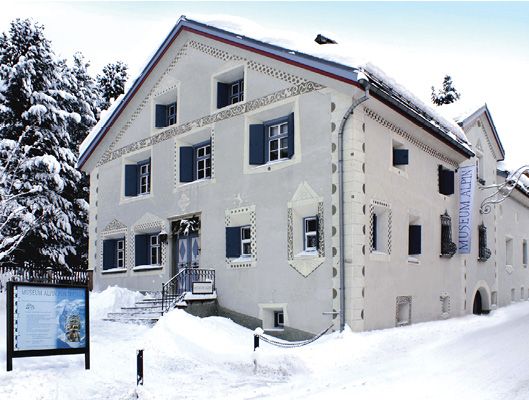
Roughly translated, Pontresina means “bridge of the Saracens,” referring to Moorish brigands who raided here in the 10th century. It has the venerable Santa Maria Church, with its Byzantine-Romanesque frescoes, as well as the ruins of the 13th century Spaniola tower. There is also the Museum Alpin, set in a historic house filled not only with artifacts of daily life from this town but ski memorabilia.
In short, you go to St. Moritz for partying, shopping and nightclubbing. You go to Pontresina because you want to gaze out your hotel window onto the moonlit Roseg Glacier, fall asleep to the bells of the San Nicolò church, and then rise early to hit the pistes.
SKI HISTORY
As St. Moritz slowly developed into a winter sports resort in the late 19th century, Pontresina followed in its footsteps. By the 1870s, the Upper Engadine valley was being transformed with the arrival of tourists, most of them upper-class British, who came to climb, to walk and, eventually, to ski.
The importance of high-born British driving this change can’t be underestimated. As in St. Moritz, guesthouses and hotels in Pontresina were expanded or built to accommodate these new visitors. By the late 19th century, the so-called English Church was built in the heart of town, the Holy Trinity Church Pontresina, which some architectural historians considered the most important work of English church architecture in Switzerland. It was razed in the mid-20th century but even today, you can see parts of it, including the altar railing donated by one of Queen Victoria’s nieces, in the Museum Alpin.
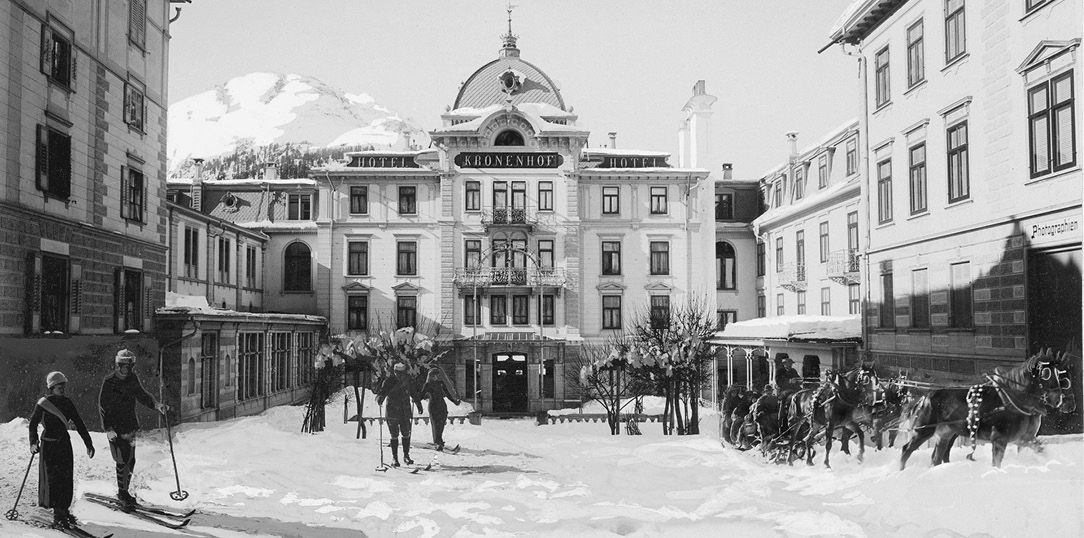
As with St. Moritz, the history of the resorts, or at least their spirit, can be found within the walls of the great hotels. What began as a modest guesthouse that opened in 1848 evolved into the Grand Hotel Kronenhof, the grandest of Pontresina’s grand hotels, by 1898. The 112-guestroom palatial hotel commands the best view of the mountains and glaciers, and in the hotel’s basement wooden skis still line the walls, some of them left behind by English guests who stored them here nearly a century ago.
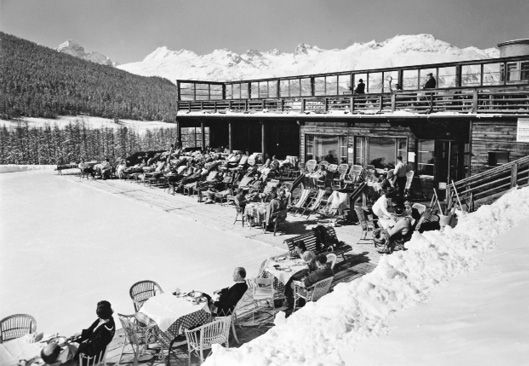
Other examples include the three-star Sporthotel Pontresina, an Art Nouveau beauty with etched glass windows and an elaborate central cast-iron stairway that opened in 1881. Swiss hotelier Leo Trippi, whose namesake company is today a luxury tour operator in London, was born in nearby Samedan and got his start in the 19th century running the family hotel in Pontresina.
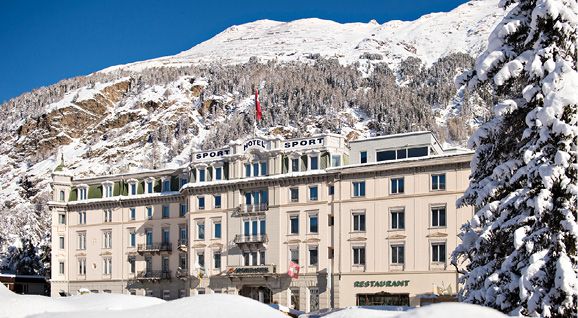
In the Victorian era, Pontresina welcomed Sir Arthur Sullivan, of Gilbert and Sullivan comic opera fame, who organized a charity concert to raise funds for the English Church while visiting. The English writers Matthew Arnold and Elizabeth Gaskell found it a great place to linger and work, as did Hans-Christian Andersen and the composer Richard Strauss. These days, with the exception of German Chancellor Angela Merkel, who spends her Christmas holidays here, the famous, the wanna-bes and their entourages head to St. Moritz for the glitz. In Pontresina, the streets and the money are quiet.
An English friend of mine has framed the bill of sale for her father’s ski trip to Pontresina in 1925, when he was a student at Oxford. It included second- and third-class rail transport from London, steamer passage across the English Channel, and 12 nights of room and board at the long-gone Hotel Park, all for a grand total of 19.83 pound sterling. It may sound cheap but in today’s currency, that would amount to about $1,612, far from a cheap ski holiday on a student budget in 1925.
THE SPORTS
The SkiClub Bernina Pontresina was founded in 1903, at the same time as the Swiss Ski Association. The focus was on ski tours, at a time when a single pole was still used in the sport.

After the world’s first bobsled club was founded in St Moritz in 1897 and a dedicated bobsled track was built in 1904, Pontresina joined the bobsled craze just a year later, in 1905, building two bobsled tracks.
As with many European ski resorts, the enthusiasm for ski jumping drove the need for infrastructure. The first ski jumping hills in Pontresina were set up in the beginning of the 20th century and allowed jumps of 20 to 30 meters. These included Clüx-Schanze, near the current valley station of the Languard ski lift, as well as Piccolischanze, which was on a steep slope below Spaniola tower. In 1907, construction of the Bernina-Sprungschanze in the Roseg valley started, which was opened officially in winter 1912 as a 40-meter hill. In 1925, under the direction of local builder and skier Luigi Costa, the SkiClub Pontresina opened a new ski jumping facility in the Val Roseg that made 80-meter jumps possible.
Up to four international competitions were held each winter and were considered the leading ones in Europe. It was in Pontresina in 1928 that the Swiss Bruno Trojani became the first ski jumper in Europe to soar more than 70 meters. A world record was set by Adolf Badrutt with a 75-meter jump in 1930. In 1948, the last competition took place but the 40-meter hill was still in use until the 1960s.
Skiing was already established in 1927 when Karl Gruber and partner Gregor Andreoli started making and selling skiing and mountaineering equipment in a small cabin on Via Maistra, the main street of Pontresina. Gruber Sport remains one of the region’s top outdoor equipment shops. Gruber’s son Erich took over the store in the 1960s, when he also was named head of the Pontresina ski school. Erich’s son Andy later assumed both roles.
In Switzerland in 1941, when the country was surrounded by Axis forces, the Swiss Army and Swiss tourism joined forces with a campaign to “help youth winter sports defend our borders.” This was more about eyes and ears looking out for the borders than outright military preparation. The very first Swiss Youth Ski Camp in Switzerland was held in Pontresina for 500 boys from “poor homes” while a similar camp was held for girls a year later, according to Michael Lutscher in his book, Snow, Sun and Stars.
The ski mountain Diavolezza is said to have received its name because a red-haired devil lived on the mountain. If nothing else, the story provided a memorable name and great devil logo. While the undulating treeless slopes still invite endless off-piste runs, access to the top was problematic for years. Plans for a funicular railway from Alp Bondo to Diavolezza or from Morteratsch through Munt Pers to the Diavolezza were floated in the 1920s. While the latter plan finally won favor in 1937, the financing fell through. Discussions resumed after the war. In 1954, the funicular idea was abandoned and a cable car was built from the valley to the top. Luftseilbahn Bernina-Diavolezza (LDB) began operating the 50-person cable car in 1956, but by the summer of 1958, it was necessary to add a larger, 62-person car. Meanwhile, a diesel-powered surface lift was built in the glacier in 1960. By 1980, a new 125-person cable car was opened.
While the 1928 and 1948 Winter Olympic Games in neighboring St. Moritz introduced the world to neighboring Pontresina, none of the medal events were held there. It does claim a footnote in Olympic lore, however. It was in Pontresina in 1948 that American skier Robert Lloyd “Barney” McLean, the captain of the U.S. Olympic Ski Team, skied several races one week before the Games began. In that January warm-up event, he took first in the downhill (Stein Eriksen came in second), third in slalom and first in combined. But in St. Moritz one week later, McLean fell in both the slalom and the downhill. He was quoted as saying afterwards, “I had run my race the week before.”
It was also in 1970 that “Club 8847—Piz Lagalb—Mount Everest” was founded. The club asked potential members to complete eleven ski runs from the Piz Lagalb, taking the Minor ski lift back up and then walking up to Piz Lagalb via a footpath and back again. If you could do this within one day, you were accepted as a member. The most famous member was the Shah of Iran, who passed the membership test in 1975 in the company of 19 bodyguards.
In a Swiss town that embraces the essence of winter, skiing is not the only pursuit in town. For more than a century, sport lovers have taken the funicular, built in 1907, up the peak of another mountain, nearby Muottas Muragl, for sledging (sledding) and tobogganing. The views from the top, beloved by painters and photographers, is a panorama overlooking the Upper Engadin Valley, from St. Moritz all the way to Italy.
Pontresina is also part of the second largest cross country ski race in the world, the Engadin Skimarathon, held every year on the second Sunday of March, between Maloja and S-chanf. The race debuted in 1969 and today welcomes upwards of 14,000 skiers annually on the 42 km race course, though some competitors choose to complete the half-marathon of 21 km that finishes in Pontresina.
As with St. Moritz and other Swiss resorts, some of the best graphic artists in the country were commissioned to create ski posters in the 20th century to advertise the resort. Arguably the best known was a now-iconic work by the Swiss artist Herbert Matter in 1935 simply called “Pontresina,” a bold photomontage of a skier wearing massive glacier goggles while another skier descends a steep piste in the background. The message seems to be that this village is not the lair of the idle rich of nearby St. Moritz but instead a place where the sport of skiing reigns supreme, an endeavor that requires skill and a sense of exploration. When you’re out on the vast white slopes of Diavolezza, that sentiment still rings true today. 
Everett Potter is a frequent contributor to Skiing History. He launched Everett Potter’s Travel Report in 2005 (everettpotter.com) and since then it has become one of the most widely read and respected digital sites in the travel industry.


Table of Contents

Corporate Sponsors
ISHA deeply appreciates your generous support!
WORLD CHAMPIONSHIP ($3,000 AND UP)
Gorsuch
Polartec
WORLD CUP ($1,000)
Aspen Skiing Company
BEWI Productions
Bogner
Boyne Resorts
Dale of Norway
Darn Tough Vermont
Dynastar | Lange | Look
Fairbank Group: Bromley, Cranmore, Jiminy Peak
Gordini USA Inc. | Kombi LTD
HEAD Wintersports
Hickory & Tweed Ski Shop
Intuition Sports, Inc.
Mammoth Mountain
Marker-Volkl USA
National Ski Areas Association (NSAA)
Outdoor Retailer
Rossignol
Ski Area Management
Ski Country Sports
Snowsports Merchandising Corporation
Sport Obermeyer
Sports Specialists, Ltd.
Sun Valley Resort
Vintage Ski World
Warren and Laurie Miller
World Cup Supply, Inc.
GOLD ($700)
Race Place | BEAST Tuning Tools
The Ski Company (Rochester, NY)
Thule
SILVER ($500)
Alta Ski Area
Boden Architecture PLLC
Dalbello Sports
Ecosign Mountain Resort Planners
Fera International
Holiday Valley
Hotronic USA, Inc. | Wintersteiger
MasterFit Enterprises
McWhorter Driscoll, LLC
Metropolitan New York Ski Council
New Jersey Ski & Snowboard Council
NILS, Inc.
Russell Mace Vacation Homes
Schoeller Textile USA
Scott Sports
Seirus Innovations
SeniorsSkiing.com
Ski Utah
Swiss Academic Ski Club
Tecnica Group USA
Trapp Family Lodge
Western Winter Sports Reps Association
World Pro Ski Tour


